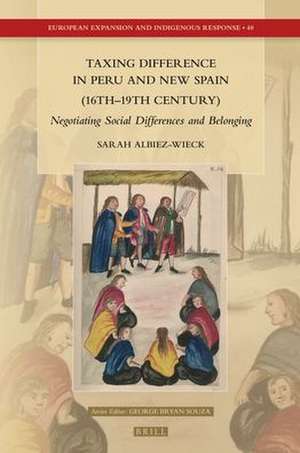Taxing Difference in Peru and New Spain (16th–19th Century): Negotiating Social Differences and Belonging: European Expansion and Indigenous Response, cartea 40
Autor Sarah Albiez-Wiecken Limba Engleză Hardback – 21 sep 2022
Din seria European Expansion and Indigenous Response
- 18%
 Preț: 1655.82 lei
Preț: 1655.82 lei - 18%
 Preț: 647.60 lei
Preț: 647.60 lei - 18%
 Preț: 660.89 lei
Preț: 660.89 lei - 18%
 Preț: 843.90 lei
Preț: 843.90 lei - 18%
 Preț: 691.71 lei
Preț: 691.71 lei - 18%
 Preț: 611.05 lei
Preț: 611.05 lei - 18%
 Preț: 631.89 lei
Preț: 631.89 lei - 18%
 Preț: 673.09 lei
Preț: 673.09 lei - 18%
 Preț: 718.77 lei
Preț: 718.77 lei - 18%
 Preț: 615.35 lei
Preț: 615.35 lei - 18%
 Preț: 615.35 lei
Preț: 615.35 lei - 18%
 Preț: 544.45 lei
Preț: 544.45 lei - 18%
 Preț: 797.08 lei
Preț: 797.08 lei - 18%
 Preț: 907.04 lei
Preț: 907.04 lei - 18%
 Preț: 1608.58 lei
Preț: 1608.58 lei - 18%
 Preț: 697.03 lei
Preț: 697.03 lei - 18%
 Preț: 548.72 lei
Preț: 548.72 lei - 18%
 Preț: 690.15 lei
Preț: 690.15 lei - 18%
 Preț: 3264.45 lei
Preț: 3264.45 lei - 18%
 Preț: 577.99 lei
Preț: 577.99 lei - 18%
 Preț: 550.57 lei
Preț: 550.57 lei - 15%
 Preț: 508.92 lei
Preț: 508.92 lei - 18%
 Preț: 567.33 lei
Preț: 567.33 lei - 18%
 Preț: 528.02 lei
Preț: 528.02 lei - 18%
 Preț: 536.26 lei
Preț: 536.26 lei - 18%
 Preț: 735.92 lei
Preț: 735.92 lei - 18%
 Preț: 600.53 lei
Preț: 600.53 lei - 18%
 Preț: 559.04 lei
Preț: 559.04 lei - 18%
 Preț: 536.26 lei
Preț: 536.26 lei - 18%
 Preț: 546.60 lei
Preț: 546.60 lei - 15%
 Preț: 499.91 lei
Preț: 499.91 lei - 18%
 Preț: 624.36 lei
Preț: 624.36 lei - 18%
 Preț: 714.09 lei
Preț: 714.09 lei - 18%
 Preț: 818.40 lei
Preț: 818.40 lei - 18%
 Preț: 662.42 lei
Preț: 662.42 lei - 18%
 Preț: 668.33 lei
Preț: 668.33 lei - 18%
 Preț: 665.93 lei
Preț: 665.93 lei
Preț: 625.24 lei
Preț vechi: 762.49 lei
-18% Nou
Puncte Express: 938
Preț estimativ în valută:
119.63€ • 125.58$ • 99.30£
119.63€ • 125.58$ • 99.30£
Carte indisponibilă temporar
Doresc să fiu notificat când acest titlu va fi disponibil:
Se trimite...
Preluare comenzi: 021 569.72.76
Specificații
ISBN-13: 9789004521636
ISBN-10: 9004521631
Dimensiuni: 155 x 235 mm
Greutate: 0 kg
Editura: Brill
Colecția Brill
Seria European Expansion and Indigenous Response
ISBN-10: 9004521631
Dimensiuni: 155 x 235 mm
Greutate: 0 kg
Editura: Brill
Colecția Brill
Seria European Expansion and Indigenous Response
Notă biografică
Sarah Albiez-Wieck, Ph.D. (2011), University of Bonn, habilitation (2021) is Interim Professor in Iberian and Latin American History at the University of Cologne. Her research interests include (post)colonialism, social differences, racism, migration, bonded labor and belonging with a geographical focus on Spanish America and the Philippines in a global context.
Cuprins
General Series Editor’s Preface
Acknowledgements
Figures and Tables
Abbreviations
Introduction
1 Comparing Cajamarca and Michoacán
1.1 Tribute, Labor and Social Units from Prehispanic to Spanish Rule
1.2 Cajamarca: between “pueblo de indios” and “villa de españoles”
1.3 Changing Capitals and Political Units in Michoacán
1.4 Demography in the Regions of Study
2 Spanish Colonial Tribute Legislation from the Sixteenth to the Nineteenth Century
2.1 Tributary Legislation: Transcending Previous Studies
2.2 Colonial Obligations besides Tribute: Indirect Taxes and Labor Service
2.3 Tribute and Tributaries: A Perspective from above
2.4 Tribute Categorizations from the Conquest to the Bourbon Reforms
2.5 The Bourbon Reforms in the Eighteenth Century
2.6 The Long Journey toward Abolition in the Nineteenth Century
3 Negotiating Belonging and “Calidad” in Petitions
3.1 The Petitions
3.2 Comparing General Patterns and Chronology
3.3 Ancestry and (il)Legitimacy as Central Elements in the Petitions
4 Petitions by People Categorized as “Migrants”
4.1 “Migrant” Petitions from Cajamarca, Peru
4.2 “Migrant” Petitions from Michoacán, New Spain
5 Petitions Negotiating “Mixed” Ancestry
5.1 Mestizos
5.2 Mulattos
5.3 Ambiguous Categorizations in Cajamarca: (mixtos) quinteros
5.4 The Relationship between laboríos and mulattos in New Spain
5.5 Petitions by Women
5.6 Unknown Ancestry: The Case of the Foundlings
6 Fiscal Categorizations after Independence
6.1 Cajamarcan Categorizations and Petitions in the Nineteenth Century
6.2 Fiscal Categorizations in Michoacán in the Nineteenth Century
7 Conclusion
Glossary
Bibliography
Index
Acknowledgements
Figures and Tables
Abbreviations
Introduction
1 Comparing Cajamarca and Michoacán
1.1 Tribute, Labor and Social Units from Prehispanic to Spanish Rule
1.2 Cajamarca: between “pueblo de indios” and “villa de españoles”
1.3 Changing Capitals and Political Units in Michoacán
1.4 Demography in the Regions of Study
2 Spanish Colonial Tribute Legislation from the Sixteenth to the Nineteenth Century
2.1 Tributary Legislation: Transcending Previous Studies
2.2 Colonial Obligations besides Tribute: Indirect Taxes and Labor Service
2.3 Tribute and Tributaries: A Perspective from above
2.4 Tribute Categorizations from the Conquest to the Bourbon Reforms
2.5 The Bourbon Reforms in the Eighteenth Century
2.6 The Long Journey toward Abolition in the Nineteenth Century
3 Negotiating Belonging and “Calidad” in Petitions
3.1 The Petitions
3.2 Comparing General Patterns and Chronology
3.3 Ancestry and (il)Legitimacy as Central Elements in the Petitions
4 Petitions by People Categorized as “Migrants”
4.1 “Migrant” Petitions from Cajamarca, Peru
4.2 “Migrant” Petitions from Michoacán, New Spain
5 Petitions Negotiating “Mixed” Ancestry
5.1 Mestizos
5.2 Mulattos
5.3 Ambiguous Categorizations in Cajamarca: (mixtos) quinteros
5.4 The Relationship between laboríos and mulattos in New Spain
5.5 Petitions by Women
5.6 Unknown Ancestry: The Case of the Foundlings
6 Fiscal Categorizations after Independence
6.1 Cajamarcan Categorizations and Petitions in the Nineteenth Century
6.2 Fiscal Categorizations in Michoacán in the Nineteenth Century
7 Conclusion
Glossary
Bibliography
Index
